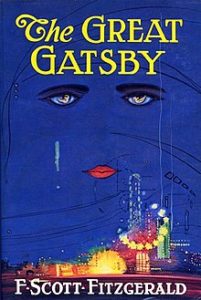Skill focus: Reflecting on the plot, quotations, characters, and symbols in The Great Gatsby
EAP Level: Advanced
Overview: First, students order key events and quotations chronologically. Later, they brainstorm characters, places, and symbols.
Materials needed: Events & Quotations from the storyline (be...low) cut into strips of paper. Each group will need a set.
Worksheet Download: Available on TPT
Time Required: 1 hour
This is a lesson plan you can do after your students have read The Great Gatsby. It's a good activity for getting the students working in groups. My main purpose in designing this was to get students prepared to write a literary essay on the topic, hence the focus on quotations.

Part 1: Plotting Events in the Story (20 Minutes)
For this activity, each group of four students need the following events cut into strips of paper.
Activity Execution (20 minutes) - Storyline
- Put students into groups of four.
- Designate a leader in each group.
- Give a set of the cards (strips of paper) to the leader of the group. Be sure they are mixed up.
- Ask the leader to 'deal' out the cards to group-mates like in poker.
- Each member should then read out a card. Their groupmates then discuss when it occurred in the book and lay it on the table in chronological order.
- Students continue until all events are laid out.
- Check answers as a whole class. Discuss together.
Part 2: Plotting Quotations from the Story (20 Minutes)
This is the same activity except that students order key quotations chronologically. If they have space, encourage them to lay the quotations alongside the storyline for reference.
...
Conduct the activity in the same manner as the previous. Encourage students to engage with the quotations -- what is their significance? If the students are writing an essay on the book, ask them if any of the quotations can support their thesis.
At this point, the students will want a change in activity type. Cue the game below.
The Great Gatsby - Brainstorming Unique Ideas Game (15 minutes)
The students are already in groups. To make the next activity more fun, I have them give their group a team name and I put it on the board.
Next, I explain the game.
- I will give the class a category, like 'Vegetables', but related to The Great Gatsby.
- Groups then have 1 minute (or two) to brainstorm (and write down) ideas that match the category ('zucchini'). One student per group, the writer, records the ideas on paper.
- Afterwards, I ask the students to read me their word lists (or take them and read them out-loud).
Groups are awarded one point for each unique response. In other words, if the category is characters in the novel, a group cannot get a point for 'Tom' if another group says it. However, if a group says 'Wolfsheim', and no one else says his name, then they earn a point.
(As a teacher, the points don't matter -- the purpose is to get students engaged with the material.)
Possible categories for the the game:
- Characters in The Great Gatsby
- Places in The Great Gatsby
- Symbols in The Great Gatsby
- Themes in The Great Gatsby
Possible Extensions:
- Add a 'Challenge' rule where other groups can challenge words on another group's list if they feel they aren't accurately related to the category.
- If you use symbols or themes, you could ask some of the higher-level students to identify which themes/symbols are stronger/weaker/suitable/unsuitable for a literary analysis thesis.
I hope that these activities are useful for your EAP/English Literature classes.
-- Matthew Barton / Creator of Englishcurrent.com
